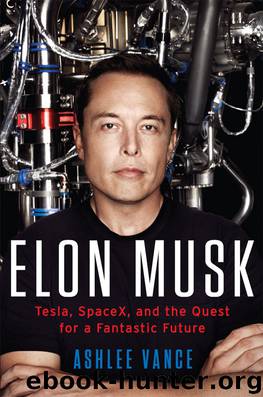Elon Musk by Ashlee Vance

Author:Ashlee Vance
Language: eng
Format: epub, mobi
Publisher: HarperCollins
Published: 2015-03-26T16:00:00+00:00
9
LIFTOFF
THE FALCON 9 HAS BECOME SPACEX’S WORKHORSE. The rocket looks—let’s face it—like a giant white phallus. It stands 224.4 feet tall, is 12 feet across, and weighs 1.1 million pounds. The rocket is powered by nine engines arranged in an “octaweb” pattern at its base with one engine in the center and eight others encircling it. The engines connect to the first stage, or the main body of the rocket, which bears the blue SpaceX insignia and an American flag. The shorter second stage of the rocket sits on top of the first and is the one that actually ends up doing things in space. It can be outfitted with a rounded container for carrying satellites or a capsule capable of transporting humans. By design, there’s nothing particularly flashy about the Falcon 9’s outward appearance. It’s the spaceship equivalent of an Apple laptop or a Braun kettle—an elegant, purposeful machine stripped of frivolity and waste.
SpaceX sometimes uses Vandenberg Air Force Base in Southern California to send up these Falcon 9 rockets. Were it not owned by the military, the base would be a resort. The Pacific Ocean runs for miles along its border, and its grounds have wide-open shrubby fields dotted by green hills. Nestled into one hilly spot just at the ocean’s edge are a handful of launchpads. On launch days, the white Falcon 9 breaks up the blue and green landscape, pointing skyward and leaving no doubt about its intentions.
About four hours before a launch, the Falcon 9 starts getting filled with an immense amount of liquid oxygen and rocket-grade kerosene. Some of the liquid oxygen vents out of the rocket as it awaits launch and is kept so cold that it boils off on contact with the metal and air, forming white plumes that stream down the rocket’s sides. This gives the impression of the Falcon 9 huffing and puffing as it limbers up before the journey. The engineers inside of SpaceX’s mission control monitor these fuel systems and all manner of other items. They chat back and forth through headsets and begin cycling through their launch checklist, consumed by what people in the business call “go fever” as they move from one approval to the next. Ten minutes before launch, the humans step out of the way and leave the remaining processes up to automated machines. Everything goes quiet, and the tension builds until right before the main event. That’s when, out of nowhere, the Falcon 9 breaks the silence by letting out a loud gasp.
A white latticed support structure pulls away from its body. The T-minus-ten-seconds countdown begins. Nothing much happens from ten down to four. At the count of three, however, the engines ignite, and the computers conduct a last, oh-so-rapid, health check. Four enormous metal clamps hold the rocket down, as computing systems evaluate all nine engines and measure if there’s sufficient downward force being produced. By the time zero arrives, the rocket has decided that all is well enough to go through with its mission, and the clamps release.
Download
This site does not store any files on its server. We only index and link to content provided by other sites. Please contact the content providers to delete copyright contents if any and email us, we'll remove relevant links or contents immediately.
| American National Standards Institute (ANSI) Publications | Architecture |
| History | Measurements |
| Patents & Inventions | Research |
Whiskies Galore by Ian Buxton(41033)
Introduction to Aircraft Design (Cambridge Aerospace Series) by John P. Fielding(32442)
Small Unmanned Fixed-wing Aircraft Design by Andrew J. Keane Andras Sobester James P. Scanlan & András Sóbester & James P. Scanlan(32199)
Craft Beer for the Homebrewer by Michael Agnew(17522)
Turbulence by E. J. Noyes(7177)
The Complete Stick Figure Physics Tutorials by Allen Sarah(6724)
Kaplan MCAT General Chemistry Review by Kaplan(6146)
The Thirst by Nesbo Jo(5880)
Bad Blood by John Carreyrou(5863)
Learning SQL by Alan Beaulieu(5537)
Weapons of Math Destruction by Cathy O'Neil(5163)
Man-made Catastrophes and Risk Information Concealment by Dmitry Chernov & Didier Sornette(4885)
iGen by Jean M. Twenge(4770)
Digital Minimalism by Cal Newport;(4733)
Life 3.0: Being Human in the Age of Artificial Intelligence by Tegmark Max(4604)
Audition by Ryu Murakami(4184)
Electronic Devices & Circuits by Jacob Millman & Christos C. Halkias(4148)
1,001 ASVAB Practice Questions For Dummies by Powers Rod(4117)
Pale Blue Dot by Carl Sagan(4113)
